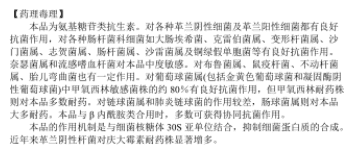1. Gentamicin has the following characteristics
1) It is a bactericidal antibiotic. 2) It belongs to the broad-spectrum aminoglycosides. 3) There is an obvious post-antibiotic effect (PAE) on Gram-negative bacteria and positive cocci, that is, it has a sustained antibacterial effect lower than the inhibitory concentration, completely eliminates the drug, or the drug concentration is lower than the minimum inhibitory concentration (MIC ), bacterial growth continues to be inhibited within a certain period of time. 4) It is a concentration-dependent antibacterial drug. Recent studies have shown that the antibacterial activity of gentamicin depends on the effective concentration of the cell membrane antibiotic. When the daily dose remains unchanged, a single administration can achieve a greater peak plasma concentration than multiple administrations a day, making the peak concentration The ratio of concentration to minimum inhibitory concentration increases, thereby significantly improving antibacterial activity and clinical efficacy. In addition, the post-antibiotic effect (PAE) of gentamicin on pathogenic bacteria is also concentration-dependent. A single daily dose can reduce the incidence of adaptive resistance and ototoxicity and renal toxicity, and can also reduce the risk of catching pigs. Stress reaction caused by drugging and injection. 5) This product is rarely absorbed when taken orally and has a high concentration in the intestine. It can be used as a medicine for intestinal infections to treat yellow and white scours and enteritis in piglets. 6) This product is rapidly and completely absorbed after injection. Peak blood concentration occurs within 0.5-1 hour of intramuscular injection, and the bioavailability can reach 90%. When the dose is increased, the blood concentration can be increased and the duration can be appropriately extended. 7) This product is an alkaline compound, easily soluble in water, relatively stable, and its antibacterial activity is strongest in an alkaline environment. 8) Gentamicin may have certain toxic side effects if used in too high a dosage or for too long a time. 9) Bacteria are also prone to develop resistance to this product, but drug-resistant strains are far less common than streptomycin and kanamycin. The occurrence can be reduced or prevented if the dosage is adequate or combined with other antibiotics and topical application is avoided. Once it occurs, stop taking the drug immediately, and the bacteria can regain sensitivity. There is incomplete cross-resistance among different varieties of aminoglycosides. 2. Drug interactions 1) Gentamicin is used in combination with β-lactam antibiotics (such as penicillins or cephalosporins), which is usually effective against a variety of Gram-negative bacteria, including green Pseudomonas, etc. have synergistic effects. It also has a synergistic effect on Gram-positive bacteria. For example, gentamicin is combined with penicillin against Streptococcus aureus, combined with enzyme-resistant semi-synthetic penicillin against Staphylococcus aureus, combined with cephalosporins against Pneumoniae bacteria, and combined with penicillin G or ampicillin against Listeria and Listeria Carbenicillin acts jointly against Pseudomonas aeruginosa, etc. This is because beta-lactam drugs cause bacterial cell wall damage and can increase the uptake of gentamicin by the bacterial cell membrane, because the damage to the cell wall makes it easier for the drug to access the cell membrane. 2) Combined with trimethoprim-sulfonamide, it also has a synergistic effect on Escherichia coli and Klebsiella pneumoniae. 3) When treating serious systemic infections, this product can be used in combination with dexamethasone, florfenicol, etc. to achieve a higher cure rate. 4) The antibacterial effect of this product is enhanced in an alkaline environment. Combination with alkaline drugs (such as sodium bicarbonate, aminophylline, etc.) can enhance the antibacterial activity, but the toxicity will also increase accordingly. When the pH value exceeds 8.4, the antibacterial effect decreases. 5) It is forbidden to mix it with vitamin C to avoid reducing the efficacy. 3. Indications Gentamicin has good efficacy in treating serious infections caused by sensitive bacteria. Clinically, it is mainly used to control and treat local and systemic infections caused by drug-resistant Staphylococcus aureus, Pseudomonas aeruginosa, Escherichia coli, Proteus, Pasteurella, Salmonella and other aerobic Gram-negative bacteria. Such as sepsis, urogenital tract infection, respiratory tract infection (pneumonia, bronchopneumonia), gastrointestinal infection (including peritonitis), mastitis, osteoarthritis and skin and soft tissue infection, etc. 4. Usage and Dosage The potency of this product is calculated by weight, 1 gram is equal to 1 million units. 1) Take orally for one day, 10-15 mg per kilogram of body weight, 2-3 times a day, for 2-3 days. 2) Intramuscular injection: one dose, 2-4 mg per kilogram of body weight, twice a day, for 2-3 days. The above is the dosage recommended by the official "Guidelines for the Use of Veterinary Drugs". The following is a prescription for treating piglet diarrhea, which is summarized by the author after ten years of repeated testing. The dosage is larger than the official recommended dosage, and the clinical effect is good. Those who are interested may wish to give it a try: 5.0 grams of gentamicin powder, methoxy 1.0 g of benzylamine, 20 scopolamine tablets (5 mg/tablet), 13.75 g of oral rehydration salt, 500 ml of cold water, taken orally once, 1 ml per kilogram of body weight, twice a day, for 2-3 days. If you want to reduce the stress caused by catching pigs, you can also give it only once a day, 2.0 ml per kilogram of body weight. If the weight of the piglets exceeds 10kg and it is inconvenient to administer the medicine, gentamicin injection can be injected intramuscularly. Intramuscular injection of 6-8mg per kilogram of body weight, that is, 0.15-0.2ml of 4% gentamicin injection per kilogram of body weight, twice a day for 2-3 days. If administered intramuscularly once daily, the dose may be doubled. For severe cases of dehydration, gentamicin injection can also be added to 20-40ml of 5% glucose saline for intraperitoneal injection. For severe cases, regardless of oral administration, intramuscular injection or intraperitoneal injection, the dosage can be appropriately increased as appropriate.
2. Drug interactions 1) Gentamicin is used in combination with β-lactam antibiotics (such as penicillins or cephalosporins), which is usually effective against a variety of Gram-negative bacteria, including green Pseudomonas, etc. have synergistic effects. It also has a synergistic effect on Gram-positive bacteria. For example, gentamicin is combined with penicillin against Streptococcus aureus, combined with enzyme-resistant semi-synthetic penicillin against Staphylococcus aureus, combined with cephalosporins against Pneumoniae bacteria, and combined with penicillin G or ampicillin against Listeria and Listeria Carbenicillin acts jointly against Pseudomonas aeruginosa, etc. This is because beta-lactam drugs cause bacterial cell wall damage and can increase the uptake of gentamicin by the bacterial cell membrane, because the damage to the cell wall makes it easier for the drug to access the cell membrane. 2) Combined with trimethoprim-sulfonamide, it also has a synergistic effect on Escherichia coli and Klebsiella pneumoniae. 3) When treating serious systemic infections, this product can be used in combination with dexamethasone, florfenicol, etc. to achieve a higher cure rate. 4) The antibacterial effect of this product is enhanced in an alkaline environment. Combination with alkaline drugs (such as sodium bicarbonate, aminophylline, etc.) can enhance the antibacterial activity, but the toxicity will also increase accordingly. When the pH value exceeds 8.4, the antibacterial effect decreases. 5) It is forbidden to mix it with vitamin C to avoid reducing the efficacy. 3. Indications Gentamicin has good efficacy in treating serious infections caused by sensitive bacteria. Clinically, it is mainly used to control and treat local and systemic infections caused by drug-resistant Staphylococcus aureus, Pseudomonas aeruginosa, Escherichia coli, Proteus, Pasteurella, Salmonella and other aerobic Gram-negative bacteria. Such as sepsis, urogenital tract infection, respiratory tract infection (pneumonia, bronchopneumonia), gastrointestinal infection (including peritonitis), mastitis, osteoarthritis and skin and soft tissue infection, etc. 4. Usage and Dosage The potency of this product is calculated by weight, 1 gram is equal to 1 million units. 1) Take orally for one day, 10-15 mg per kilogram of body weight, 2-3 times a day, for 2-3 days. 2) Intramuscular injection: one dose, 2-4 mg per kilogram of body weight, twice a day, for 2-3 days. The above is the dosage recommended by the official "Guidelines for the Use of Veterinary Drugs". The following is a prescription for treating piglet diarrhea, which is summarized by the author after ten years of repeated testing. The dosage is larger than the official recommended dosage, and the clinical effect is good. Those who are interested may wish to give it a try: 5.0 grams of gentamicin powder, methoxy 1.0 g of benzylamine, 20 scopolamine tablets (5 mg/tablet), 13.75 g of oral rehydration salt, 500 ml of cold water, taken orally once, 1 ml per kilogram of body weight, twice a day, for 2-3 days. If you want to reduce the stress caused by catching pigs, you can also give it only once a day, 2.0 ml per kilogram of body weight. If the weight of the piglets exceeds 10kg and it is inconvenient to administer the medicine, gentamicin injection can be injected intramuscularly. Intramuscular injection of 6-8mg per kilogram of body weight, that is, 0.15-0.2ml of 4% gentamicin injection per kilogram of body weight, twice a day for 2-3 days. If administered intramuscularly once daily, the dose may be doubled. For severe cases of dehydration, gentamicin injection can also be added to 20-40ml of 5% glucose saline for intraperitoneal injection. For severe cases, regardless of oral administration, intramuscular injection or intraperitoneal injection, the dosage can be appropriately increased as appropriate.  5. Precautions for use 1) Although gentamicin can be used in combination with penicillins or cephalosporins, it cannot be diluted with gentamicin injection, and cannot be mixed in the same syringe or sling. Inject in the bottle, otherwise the efficacy of gentamicin will be reduced. Penicillin and gentamicin can be injected intramuscularly or instilled separately. 2) When newborn piglets have not eaten colostrum, it is best not to take gentamicin to prevent jaundice in piglets. The author once credulously believed in articles published in some newspapers and magazines, saying that giving piglets 60,000 units of gentamicin before they eat colostrum can prevent jaundice in piglets. The author tried this and found that 6 of 10 piglets died one after another. The cause of death was severe ulcers at the bottom of the stomach. The author recommends that piglets that have not eaten colostrum and have an empty stomach should not take gentamicin to prevent jaundice, so as to avoid gastric ulcers and undue losses. 3) This product cannot be used in combination with similar aminoglycoside drugs such as streptomycin, kanamycin, amikacin, neomycin, etc. to prevent increased toxicity. 4) This product cannot be injected intravenously as it may cause respiratory depression.
5. Precautions for use 1) Although gentamicin can be used in combination with penicillins or cephalosporins, it cannot be diluted with gentamicin injection, and cannot be mixed in the same syringe or sling. Inject in the bottle, otherwise the efficacy of gentamicin will be reduced. Penicillin and gentamicin can be injected intramuscularly or instilled separately. 2) When newborn piglets have not eaten colostrum, it is best not to take gentamicin to prevent jaundice in piglets. The author once credulously believed in articles published in some newspapers and magazines, saying that giving piglets 60,000 units of gentamicin before they eat colostrum can prevent jaundice in piglets. The author tried this and found that 6 of 10 piglets died one after another. The cause of death was severe ulcers at the bottom of the stomach. The author recommends that piglets that have not eaten colostrum and have an empty stomach should not take gentamicin to prevent jaundice, so as to avoid gastric ulcers and undue losses. 3) This product cannot be used in combination with similar aminoglycoside drugs such as streptomycin, kanamycin, amikacin, neomycin, etc. to prevent increased toxicity. 4) This product cannot be injected intravenously as it may cause respiratory depression.

 扫一扫微信交流
扫一扫微信交流
发布评论